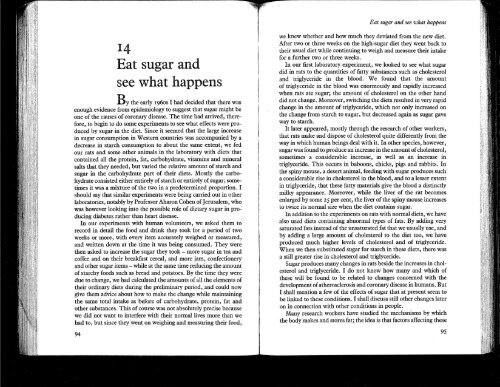John_Yudkin_-_Pure_White_and_Deadly_revised_1986_OCR
John_Yudkin_-_Pure_White_and_Deadly_revised_1986_OCR
John_Yudkin_-_Pure_White_and_Deadly_revised_1986_OCR
You also want an ePaper? Increase the reach of your titles
YUMPU automatically turns print PDFs into web optimized ePapers that Google loves.
Eat sugar <strong>and</strong> see what happens<br />
14<br />
Eat sugar <strong>and</strong><br />
see what happens<br />
By the early 1960s I had decided that there was<br />
enough evidence from epidemiology to suggest that sugar might be<br />
one of the causes of coronary disease. The time had arrived, therefore,<br />
to begin to do some experiments to see what effects were produced<br />
by sugar in the diet. Since it seemed that the large increase<br />
in sugar consumption in Western countries was accompanied by a<br />
decrease in starch consumption to about the same extent, we fed<br />
our rats <strong>and</strong> some other animals in the laboratory with diets that<br />
contained all the protein, fat, carbohydrate, vitamins <strong>and</strong> mineral<br />
salts that they needed, but varied the relative amount of starch <strong>and</strong><br />
sugar in the carbohydrate part of their diets. Mostly the carbohydrate<br />
consisted either entirely of starch or entirely of sugar; sometimes<br />
it was a mixture of the two in a predetermined proportion. I<br />
should say that similar experiments were being carried out in other<br />
laboratories, notably by Professor Aharon Cohen of Jerusalem, who<br />
was however looking into the possible role of dietary sugar in producing<br />
diabetes rather than heart disease.<br />
In our experiments with human volunteers, we asked them to<br />
record in detail the food <strong>and</strong> drink they took for a period of two<br />
weeks or more, with every item accurately weighed or measured,<br />
<strong>and</strong> written down at the time it was being consumed. They were<br />
then asked to increase the sugar they took - more sugar in tea <strong>and</strong><br />
coffee <strong>and</strong> on their breakfast cereal, <strong>and</strong> more jam, confectionery<br />
<strong>and</strong> other sugar items - while at the same time reducing the amount<br />
of starchy foods such as bread <strong>and</strong> potatoes. By the time they were<br />
due to change, we had calculated the amounts of all the elements of<br />
their ordinary diets during the preliminary period, <strong>and</strong> could now<br />
give them advice about how to make the change while maintaining<br />
the same total intake as before of carbohydrate, protein, fat <strong>and</strong><br />
other substances. This of course was not absolutely precise because<br />
we did not want to interfere with their normal lives more than we<br />
had to, but since they went on weighing <strong>and</strong> measuring their food,<br />
94<br />
we knew whether <strong>and</strong> how much they deviated from the new diet.<br />
Mter two or three weeks on the high-sugar diet they went back to<br />
their usual diet while continuing to weigh <strong>and</strong> measure their intake<br />
for a further two or three weeks.<br />
In our first laboratory experiment, we looked to see what sugar<br />
did in rats to the quantities of fatty substances such as cholesterol<br />
<strong>and</strong> triglyceride in the blood. We found that the amount<br />
of triglyceride in the blood was enormously <strong>and</strong> rapidly increased<br />
when rats ate sugar; the amount of cholesterol on the other h<strong>and</strong><br />
did not change. Moreover, switching the diets resulted in very rapid<br />
change in the amount of triglyceride, which not only increased on<br />
the change from starch to sugar, but decreased again as sugar gave<br />
way to starch.<br />
It later appeared, mostly through the research of other workers,<br />
that rats make <strong>and</strong> dispose of cholesterol quite differently from the<br />
way in which human beings deal with it. In other species, however,<br />
sugar was found to produce an increase in the amount of cholesterol,<br />
sometimes a considerable increase, as well as an increase in<br />
triglyceride. This occurs in baboons, chicks, pigs <strong>and</strong> rabbits. In<br />
the spiny mouse, a desert animal, feeding with sugar produces such<br />
a considerable rise in cholesterol in the blood, <strong>and</strong> to a lesser extent<br />
in triglyceride, that these fatty materials give the blood a distinctly<br />
milky appearance. Moreover, while the liver of the rat becomes<br />
enlarged by some 25 per cent, the liver of the spiny mouse increases<br />
to twice its normal size when the diet contains sugar.<br />
In addition to the experiments on rats with normal diets, we have<br />
also used diets containing abnormal types of fats. By adding very<br />
saturated fats instead of the unsaturated fat that we usually use, <strong>and</strong><br />
by adding a large amount of cholesterol to the diet too, we have<br />
produced much higher levels of cholesterol <strong>and</strong> of triglyceride.<br />
When we then substituted sugar for starch in these diets, there was<br />
a still greater rise in cholesterol <strong>and</strong> triglyceride.<br />
Sugar produces many changes in rats beside the increases in cholesterol<br />
<strong>and</strong> triglyceride. I· do not know how many <strong>and</strong> which of<br />
these will be found to be related to changes concerned with the<br />
development of atherosclerosis <strong>and</strong> coronary disease in humans. But<br />
I shall mention a few of the effects of sugar that at present seem to<br />
be linked to these conditions. I shall discuss still other changes later<br />
on in connection with other conditions in people.<br />
Many research workers have studied the mechanisms by which<br />
the body makes <strong>and</strong> stores fat; the idea is that factors affecting these<br />
95



